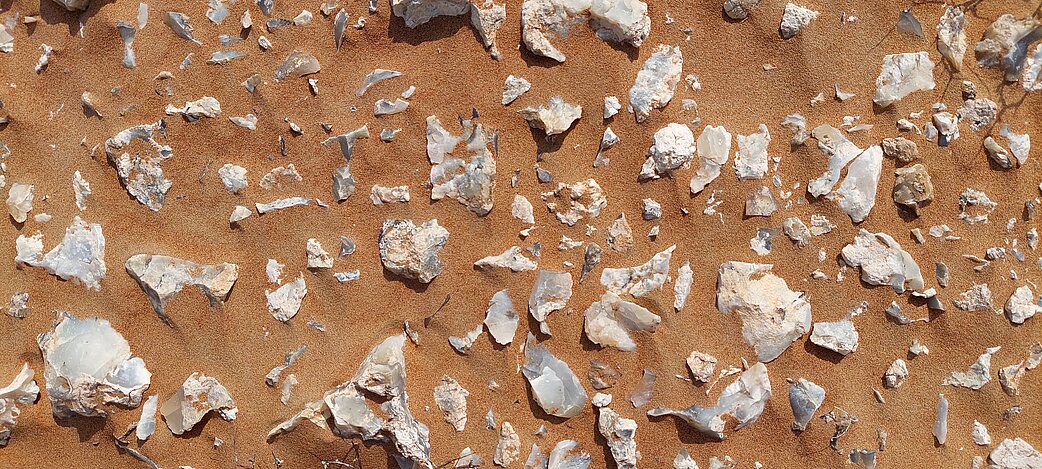Lithic Resources at Kalba (LITRAK)
Recent excavations at the site of Kalba, located at the Gulf of Oman, conducted in a joint investigation between the OeAI and the SAA, have demonstrated that Kalba was an important node for trade and communication in the region. The archaeological fieldwork at Kalba is undertaken in the framework of the project »Kalba: Research on Bronze Age Trade Networks and Resource Management Strategies« (PI: B. Horejs). The site was occupied for approximately 2000 years from the 3rd to the 1st mill. BC, covering the Umm an-Nar to the Iron Age Periods. For the local economy, various stone materials appear to have played a significant role. Additional to its character as a trade post, the presence of semi-finished products and waste material from the production cycle indicate the manufacturing of stone objects on-site.
Linked to the excavation endeavours, the TrackingLithic Resources at Kalba (LITRAK) project was initiated, with the goal to reconstruct lithic resource management strategies and particularly to track resource procurement using Kalba as a case study. This integrated project focuses on the lithic key resources determined at the site. The analyses will be performed at the Lithic Lab at the OeAI and the associated Laser Lab at the University of Graz. Following a multi-technique analytical protocol specifically designed for the characterisation and provenance analyses of the individual stone raw materials from Kalba`s lithic assemblage, the LITRAK project is designed as a three-stage program:
Stage 1: Raw materials for chipped stone tools
As demonstrated by a pilot study, the chipped stone industry at Kalba involves lithic raw materials such as chert and jasper. The planned in-depth examinations involve microscopic microfacies analysis coupled with geochemistry employing Laser Ablation ICP-MS complemented by statistical data evaluation according to the Multi Layered Chert Sourcing Approach (MLA). Additionally, non-destructive Fourier Transform Infrared Spectrometry (FTIR) will be implemented as a new technique.
Stage 2: Semiprecious stones for ornaments
Stone beads and ornaments at Kalba and sites in the immediate surrounding were produced from semiprecious stones such as chalcedony, agate and carnelian. Since these materials fall within the category of siliceous rocks similar to chert, the same analytical strategy as intended for the chipped stone tools will be applied. In this case, FTIR as a non-destructive method will be of specific importance since it is not possible to sample these precious artefacts.
Step 3: Materials for stone vessels (metamorphites)
Additional to siliceous rocks, metamorphic rocks were used for the production of stone vessels. Traditionally, it is assumed that the raw materials are entirely of exogenous origin. The variety of raw materials within the stone vessel assemblage of Kalba and the presence of half-finished products, on the other hand, suggest a more local origin of at least part of the material. Geo-archaeological surveys have revealed the great potential for this hypothesis, which will be tested during the third stage of the project.
The resulting database will be made available online after publication and will be hosted at the OeAI. This information will be a valuable resource for researchers working throughout the UAE on projects from Prehistory to historical periods, since it is also planned to extend the geographical focus and include geological materials from other areas into the current geo-archaeological scope.





